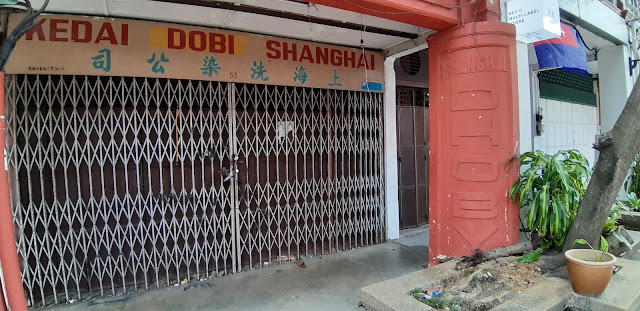多美歌(Dhoby Ghaut)地铁站是新加坡地铁南北线(红线)、环线(黄线)及东北线(紫线)交会的转换站,深入地底28公尺。 1987年启用时,属于第一批南北线站之一。
多美歌,神来之笔!不知道是谁将出自淡米尔文的“dhoby
ghaut”翻译得这么诗意。关于dhoby ghaut的原意, dhoby指的是 “洗衣”,ghaut指“沿着梯阶走到河流”,想象捧着衣物婀娜多姿一步步走下小河,边洗衣边对歌,这样的电影画面确实是挺浪漫的。
如今dhoby消失了,ghaut隐藏在地底下,历史记忆保留在多美歌地铁站的名字里。
早期印度洗衣业者
来自印度的洗衣业者是多美歌一带曾经出现过的关键职业群体,最早期来自印度南部的Bihar 和 Uttar Pradesh,有些则从马德拉斯(Madras,如今称为清奈Chennai)跟着英国殖民地军队来到新加坡。从印度外派到新加坡的官员也将印度仆人带来,帮他们洗衣服做家务。
虽然百年来,这些印度人在新加坡从事洗衣业,但跟那个时代的多数移民拥有类似的心态,没有在本地长远定居的意图。男人单身匹马来到这里工作,每三、四年返回印度一次,在家乡成家。他们永返印度之前,通常会带着一个儿子或亲戚过来,继承他们的业务。
消失的洗衣甘榜
早在1830年代,印度洗衣工人已经在多美歌的史丹福水道(Stamford Canal)洗衣服,在国泰戏院前的草场(Dhoby
Green)晾干。明古连(Bencoolen)地铁站B出口前方的新加坡管理大学(SMU),就是草场原址。
从前的史丹福水道称为Sungei Bras Bassa,马来文原意 “湿米河”,船只载来的湿米在河边晒干,可见小河还有其他用途。
从前印度人(淡米尔人)把奎因街(Queen Street)称为Dhoby Kampam,马来人称为Kampong
Dhobi,指的都是以洗衣为主的甘榜[1]。1842年的新加坡自由报称它为Campong Dhoby[2]。
Dhoby也出现在新加坡人常到的新山和槟城,新山有条跟陈旭年街平行的“洗衣街”(Jalan Dhoby),槟城的“洗布桥”(Dhoby
Ghaut)在Sungai Air Hitam和Pinang River两条河流的交界。
遗忘的记忆
根据Dandayodapani Kasinathan的口述历史[3],上世纪50至60年代新加坡的印度人洗衣店包括Vasantha Laundry, Narayanasamy Laundry, Marimuthu Laundry, Karrupiah
Laundry等,欧洲人和淡米尔人是他们的主要客户。1950至1980 年间,许多源自印度Kasangadu地区的淡米尔人在波东巴西居住,主要从事洗衣业务。
NG Seng Mun 的口述历史[4]指出,印度人是洗衣业的主要群体,他们大多聚集在实龙岗路(Serangoon
Road)或实利基(Selegie),也就是小印度一带。殖民地政府将所有机构的合同都给了印度人。20 世纪 60 年代以前,新加坡的医疗机构如 中央医院和竹脚妇幼医院(KK),洗衣房都是由印度承包商使用洗衣机操作的。印度承包商也包办英军生意。
根据那个时期的报章,或许政府也是洗衣业的主要业者。例如1958年殖民地政府时期,欧南路监狱洗涤衣服128万多件,樟宜监狱121万多件,这些衣服多数来自政府医院。1960年自治邦政府拨款83万元发展监狱工业,大部分用来扩充洗衣组,添置自动化洗衣设备等。
早年华人洗衣业者主要是三江宁波和广东鹤山人
华人是新加坡的主要族群,华人洗衣业曾经风光过。根据区如柏的报道[5],上世纪80年代前,本地从事洗衣业的华族方言群主要是三江帮和广东帮,三江帮多数是宁波人,广东帮多数是鹤山人。
昔日鹤山人经营的洗衣店分布新加坡各地,大多数是郭、林、陈、邓四姓乡亲,这个传统与早年鹤山人南来,投靠乡亲、宗亲有关系。远渡重洋到美国、加拿大的鹤山人也多数从事洗衣业。
历史最悠久的鹤山人洗衣店可能是20世纪初成立的远东洗衣店,由姓郭的乡亲开设,发源地在丹戎巴葛,后来搬迁到直落布兰雅组屋区营业。
邓亮洪律师的祖父邓道允、父亲邓和都是从事洗衣业的鹤山乡亲。邓道允早年南来,在安顺路开设广兴洗衣店。起初,邓亮洪的父亲帮忙洗衣、熨衣,1940年自己另起炉灶,在罗敏申路(老巴刹对面)开设广隆洗衣店。
邓亮洪家族的洗衣店跟许多华人洗衣店一样,以家庭式经营,家中长幼老少都是劳动力,邓亮洪的童年和青少年就在洗衣店度过。那时候没有洗衣机,也没有先进的洗衣粉,洗涤白色棉制品或斜纹布裤子,先用铜锅烧一锅热水,把苏打粉倒入热水中捣均匀,然后把脏衣服放入水中煮沸,把污秽冲洗干净。由于苏打的侵蚀性强,污秽被洗去了,手脚也常常被侵蚀到血肉模糊。颜色衣服或丝绸衣裳必须用手洗,才不会损坏顾客的衣服。70年代初,父亲去世了,祖父早已归西,兄弟们各有自己的事业,广兴和广隆都结束营业。
我年少在水仙门居住,附近福南街有两家鹤山人的洗衣店,姓邓的乡里经营的广德和,以及姓麦的乡里经营的广兴隆,1975年结业。马房街(Supreme Court Lane)姓邓的乡里经营的广来则于1960年代末结业。这些业者不再从事洗衣业,主因是利润低,而且一年做到年卅晚,只在年初一至初四休息。
华人洗衣业的黄金时代
综合刘明“新加坡华人洗衣业”[6]和上世纪70年代的报章报道,1950至60年代初是华人洗衣业的黄金时代,1967年有3000多家洗衣店, 70年代初尚存900多间。市区每件湿洗的衣裤收费多数四毛钱;市区边缘地区如芽笼、加东、后港、汤申、甘榜峇鲁、巴西班让收费三毛;军港地区最便宜,只收两毛半。
湿洗用在普通布质,材质较好的布料必须特洗,市区收费六七毛钱;是布质好的衣服则干洗,长裤一元半,大衣两元半。干洗并非干着洗,而是使用特别“药水”(化学溶剂),只用少许甚至没有水,以免损坏布料,烫的时候必须铺一块烫布在上面 “隔布传热”,通常整个钟头才烫好一件衣服。
一般人认为洗衣只用一点水和肥皂,收费三毛钱可以净赚两毛八,蝇头小本博牛车轮,利润奇高。实际情况并非如此,只有行内人才了解。
行家术语
行家称洗衣业为“番衣”,洗衣业者自然就是“番衣佬”了。
“番衣”的由来可能是因为洗的衣服多数是洋装,机器也多数从西方入口的缘故,从前中国或华人以外都称为“番”。
番衣店洗好衣服后必须熨烫,60年代从古董的“烧炭熨斗”进入电烫斗。番衣店的另一革新是自动化,以小型洗衣机取代“煮衣”的大铜锅,“打水机”(挍干机)取代人力扭干衣服。打水后“上坑佬”把衣服吊在几十尺长的粗绳子上晒干,艳阳高照的时候,衣服很快就晒干了,万一下雨,上坑佬必须快手快脚,将衣服收下来。有时候碰到小偷把吊在绳子上的衣服偷走,番衣店必须买新衣来赔旧衣。
衣服晒干后必须“洒水”喷湿,两三件衣服卷成一团,第二天“烫衫佬”才能烫得平滑。有经验的烫衫佬一天可烫好约80件衣服,烫好的衣服必须“点数”,做标记分开放,用细绳绑扎好,一叠叠放进衣柜里,等待顾客来取货,或者送到顾客府上。从衣服送进洗衣店到归还手中,经过各个专业之手,前后共四天。
番衣店的客户来源
番衣店的客户来源可分四大类:
第一类是“门口生意”,顾客亲自将衣服送上门。这类顾客流动性较大,不合意的话就没有回头生意可做。这类顾客多数是街坊邻里,可以通过店员的交情留住他们。
第二类是“出街生意”,顾客在家等候番衣佬上门收送衣服。有些顾客住得较远,番衣佬必须骑着脚车跑到几里外跟客人接洽。看到脚车架上有包白布扎好的衣服,骑士是番衣佬的机会八九不离十。
第三类是酒店客栈,收来的多数是桌布、床单、枕头套之类的物件,一般酒店客栈的生意价格都被压得很低,“量”成为昔日的生存指标。
第四类是“火烧脚”,指的是船只抵岸早靠晚离,只有半天的时间做好收取、洗涤、熨烫和送货工作。做这类生意的番衣店,通常都有大型洗衣机,烘衣服的“干房”和整群烫衫佬待命。
市场变化
上世纪60年代末,本地的布质出现变化,从前流行的斜纹布、麻布等由轻便细薄的软布料如尼龙(nylon)和针织布料取代,不需要洗衣店代劳。
一些家庭主妇兼做“洗衫婆”,接衣服回家坐在木凳上,用洗衣板洗刷,有些甚至上门到顾客家洗衣。洗衫婆抢市场,对专做门口生意和出街生意的番衣店是个重要的打击。承接酒店客栈和过境船只生意的洗衣店下得起本钱,营业没受到影响,旅游业兴旺时更需要这类洗衣店的服务。
随着城市现代化,洗衣机开始普及,专做家庭生意的洗衣业大缩水,不过干洗或窗帘之类大物件的生意还是有得做的。
近十多年来,24小时自助洗衣店进军组屋区,最初目标瞄准不方便在家里洗衣服的外籍客工和短期旅行的外地人。一些忙于工作、无暇料理家务的年轻夫妇、独居老人、活动不方便人士也搭上这趟便利的列车。
遇上雨季,这些自助洗衣店内的烘干机特别抢手。例如2022年底,东北季候风带来长命雨,衣服、床单和被单都无法在住家晾干。全岛设立16家分店的Ocean Wash自助洗衣店、Laundry Yes、易洗洗衣店(Easy Wash)业者都表示,雨季期间烘干机服务的需求增加近一倍,有些顾客排队一小时才能使用服务。不过无论如何,全岛几千家洗衣店的辉煌岁月不可能复返。
参考资料
1. URA 网站https://www.ura.gov.sg/Conservation-Portal/Explore/History?bldgid=QNST accessed 16 August 2023
2. The Singapore Free Press and Mercantile
Advertiser, 19 May 1842
3. NAS Accession Number 001264, Reel/Disc 4
4. NAS Accession Number 000852, Reel/Disc 6
5. 《联合早报》1989年9月17日
6. 收录在《南洋文摘》总第140期,1971年















%E3%80%82.jpg)




